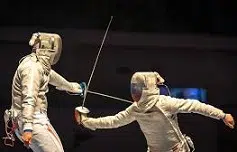 The skill of fencing is called fencing : manipulating a sword, protecting oneself from the rival's attacks and attacking; or use something as a weapon to achieve a certain objective. The most common use of the concept refers to a sport that is part of the Olympic Games .
The skill of fencing is called fencing : manipulating a sword, protecting oneself from the rival's attacks and attacking; or use something as a weapon to achieve a certain objective. The most common use of the concept refers to a sport that is part of the Olympic Games .
This combat sports discipline pits two people against each other using a bladed weapon (a foil, a sword or a saber). The objective is to touch the opponent with the weapon and prevent the rival from doing the same.
To avoid injuries , fencers use a special suit and a protective mask. Every time one of the participants (also called shooters) manages to touch their opponent, they get a point .
The rules of fencing vary according to the modality. While in sword fencing you can touch your opponent anywhere on the body, in saber fencing the attack can be made to the torso, arms and head. Foil fencing, for its part, only allows touches on the torso.
It should be noted that foils and swords must have a minimum blade length of 90 centimeters and a maximum length of 110 centimeters. In the case of sabers , the minimum length is 88 centimeters and the maximum is 105 centimeters. Sabers and foils, on the other hand, must weigh less than 500 grams; swords, less than 750 grams.
Beyond sports fencing , there are also artistic fencing (based on combat choreographies) and stage fencing (choreographies within the framework of shows, historical recreations, etc.).
Regarding the different poses and displacement movements of fencing, we can point out many points to take into account. First we have the guard , the most important pose and the one that gives rise to all attacks. Guard instructions depend in part on the weapon the fencer uses, as this affects the position of the arm and the weapon itself. For example, with the foil, the tip of the weapon should be tilted slightly upward, since the arm should not be protected because it is not a valid target, but with the epee the forearm is placed horizontally.
 The fundamental movement is the march , which is carried out forward by raising the right foot and while rotating the left so that only the heel rests, which will be the point on which all the weight will fall. Next, you must move forward with your right leg, and support your foot completely at the same time as you move the other foot forward.
The fundamental movement is the march , which is carried out forward by raising the right foot and while rotating the left so that only the heel rests, which will be the point on which all the weight will fall. Next, you must move forward with your right leg, and support your foot completely at the same time as you move the other foot forward.
It is important not to lose your guard position while marching, to avoid being left unprotected. Although during the training stage the movements are exaggerated to distinguish them correctly, professionals only lift their right foot a few centimeters to advance.
One of the basic movements of fencing is called breaking , and it consists of a backward movement that begins with the left foot, which must be raised very slightly without altering the position of the right. Just as in walking, only the heel should be supported on the right foot . To return to the guard position it is necessary to move the right foot backwards once the left foot has been supported.
Regarding the basic attacks using foil or sword, we can name the line (it is used so that the opponent cannot get too close and gives rise to other attacks ), the background (the heels are aligned and the right foot is raised as if to perform a march but leaving the entire sole of the left supported and then advance until supporting the right leg at a right angle, stretching the left arm almost at the same time) and the counterattack (a bottom followed by a guard position with the armed arm on the head, with the weapon pointed towards the ground and the legs closer than in the guard).
